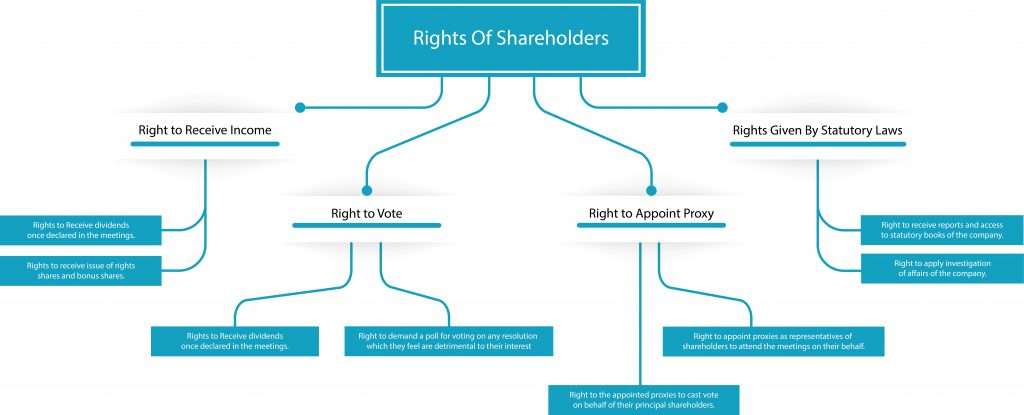Your mind immediately registers that the term shareholder refers to contributing anything, whether it is capital or other elements. Depending on the type of control and ownership there are various types of shareholders. Before understanding the types of shareholders, you must first know what shareholders are, what their roles are in a business, and how shareholding works.
A natural person or a legal organisation that owns stock in one or more firms is referred to as a shareholder. However, not every shareholder is created equally. The opportunity to vote on significant company decisions and dividend payments are both available to shareholders. Some owners, however, are passive investors who receive an annualised return on investment (ROI).
Shareholders may be thought of as the people who possess shares in a corporation.
A natural person or legal business organization that an organization has recognized as the true owner of a share of such a private or public corporation’s share capital is known as a shareholder. Corporate members are another term for shareholders.
A shareholder must possess at least one share of a particular value or mutual fund to be regarded as a partial owner. A sizable sum of dividends is frequently paid to shareholders if the company operates profitably and achieves success in the market.
Owners of preference shares, respectively, are referred to as preference shareholders, depending on whether a corporation has raised money by this type of claim.
Startup Shares Explained: How to Structure Ordinary and Advisory Equity
Key points About Shareholders
- A shareholder may only possess one share of the company.
- Shareholders may be responsible for capital gains (or losses) and/or dividend payments as residual claimants on a company’s earnings.
- Additionally, shareholders have certain rights, including the power to approve the board of directors, dividend payments, and mergers during shareholder meetings.
- In the case of insolvency, investors might lose all they invested.
The organisational form of the corporation gives each shareholder a variety of rights and yields or earning potentials, which, depending on the circumstances, may be advantageous.
Types of Shareholders
These are the 2 classifications of shareholders:
1. Common Shareholder
2. Preferred Shareholder
Common Shareholders
The owners of a company’s common shares are known as ordinary or common shareholders. They are the more common kind of shareholders and have the right to cast ballots on decisions affecting the firm. They have the authority to sue the business as a group for any misconduct that could endanger the organisation since they influence how it is run.
The common shareholder has the authority to make recommendations and to cast votes in corporate decisions. The shareholders may also choose the board of trustees. The candidate for the board of trustees is selected by the other shareholders. If the firm is being liquidated, the shareholder can get a portion of the revenues from the sale of the assets, supposing the creditors have already been paid.
The common shareholders are usually referred to as “members.” Whenever individuals register their respective names to the association memorandum during the business formation procedure, the founders of a business are referred to as “subscribers.” These people sign up for the company and consent to join.
Preferred Shareholders
Due to their choice over the company’s profits, preferred shareholders get dividend payments before ordinary shareholders. Preferred shareholders, bondholders, and debtors get distributions of the Company’s assets in that sequence; common shareholders receive distributions last.
In the corporation, they are not permitted to speak or cast ballots. Instead, they get a fixed amount from the company as a shareholder. It is the yearly dividend with a defined amount. They receive this amount even before the common shareholders are compensated. The dividend yield of preferred stock is calculated by deducting the dividend payment from the stock price.
Does a Shareholder Face a Loss if the Company Faces a Loss?
The shareholder has lesser liability in comparison to the member in a partnership firm since there is no personal financial loss for the shareholders’ personal assets. His only “loss” is from the corporation, namely from the fall in net asset value.
How Does Shareholding Work?
Shareholders operate by making an initial cash investment as an element of their investment. You can acquire ownership of a publicly traded company by investing in it. In exchange for their investments, companies provide shareholders with specific voting and decision-making rights.
It is possible to invest in private companies to become a shareholder, but the process requires negotiating with the company directly instead of through the stock market. A company could already be publicly traded, and public or it might go through an IPO to become publicly listed (IPO).
You may start buying company shares using your brokerage and a brokerage company by finding the company’s ticker symbol utilising a search tool. When registering to become a shareholder, consider the firm and corporation you want to join and ensure all the legal requirements are met. By taking such precautions, you reduce your chance of being duped.
You can also join the company’s memorandum from when it was established to become a stakeholder. Acquiring, donating, or inheriting shares from a current shareholder and purchasing in exchange for more business shares.
Role And Duties of a Shareholder
The Shareholder must participate in business operations and endeavour to improve the company; being a shareholder involves more than just making financial investments and ignoring business matters.
One of a shareholder’s responsibilities is to consider and choose the authorities they would grant to the board of directors, such as the power to nominate and remove them from their positions.
- Estimating the salaries and quantities of the directors. The process is challenging because investors must make sure their contribution will support the director’s living expenses and living costs without endangering the company’s bottom line.
- Making decisions about issues that are out of the directors’ control, such as altering the company’s charter
- The financial accounts of the firm are examined and approved.
- The company’s charter changes
- A dividend announcement
- Presenting the company’s financial statements for approval
- The voluntary liquidation of a corporation
Shareholders may utilise recommendations or general meetings to cast votes on pertinent resolutions and judge the performance of the business. General meetings come in two types: annual (AGM), which happens once a year, and exceptional (EGM), which happens as needed.
A shareholder may choose a proxy to represent them if they will be unable to address a general meeting.
Shareholders may call a conference and propose the resignation of directors or the board as a whole, or they may amend the bylaws to limit the power of the director, but they are not permitted to influence the choices made by the director or to intervene in the management of the business.
The corporation is not governed by its stockholders. However, the law places an obligation on shareholders to ensure that the company is run effectively through their right to vote, the authority to pay dividends, and the review of the company’s financial reports.
Rights of a Shareholder: The Companies Act of 2006
The Companies Act of 2006 states that significant business actions that would affect shareholders’ rights require special resolution from the shareholders at a public meeting called by the company’s directors.
Economic Rights
Corporate investors invest to make money off of their investments. Through dividends or the sales of their shares, shareholders have the right to a share of a company’s earnings. In addition, Delaware Code Section 281 states that investors are entitled to the firm’s net proceeds upon its dissolution in the case of bankruptcy.
Powers of Control
Voting rights on business-related matters, such as selecting directors, offer shareholders influence without actually running the corporation. Additionally, proxy statements are typically sent to shareholders by email from their broker.
Through a procedure known as unthinking voting, brokers may still be permitted to vote on an investor’s behalf although individuals don’t cast a ballot, albeit only on routine topics.
Dodd-Frank The government adopted the – Frank Wall street Protection Act in 2010, placing limits on it that prohibited voting on CEO compensation and members of the board on the Stock Exchange of New York (NYSE) and Nasdaq.
Information Rights
Shareholders have a right to certain firm information, such as financial statements. Investors may also request in writing, with five days’ notice, information on board minutes of meetings and access to the company’s articles of incorporation. A list of stockholders as well as fundamental papers like the constitution and bylaws may be viewed. Investors must demonstrate that their request is reasonable and has a purpose in tot extra information regarding viewing the books or the articles of incorporation.

Litigation Rights
If there are actions taken by the executive shareholders that aren’t in keeping with their fiduciary obligation, the shareholders are entitled to sue the company.
Investors can file a formal lawsuit or a subsidiary case against the corporation if specific practices have been broken, albeit they cannot do so for any reason. According to Clark, “The Company Law gives common stockholders the ownership rights, the authority to vote, the right to dividends, the right to transfer control, the right to use, and the right to see papers of the corporation.”
The 10 Basic Rights of Shareholders
Access to Information
Owners have access to the organisation’s financial and operational information. Private enterprises are not required to reveal any of this information to the public or their shareholders; in contrast, publicly traded companies are obligated to make it accessible to the public. Private business shareholders must submit special requests to examine financial reports or governance documentation.
Voting Rights
Investors can cast their votes for the directors they like at the annual meeting. They can either support a director nominee put forth by the nominating committee of the board of governors or put up a different candidate. In the latter case, shareholders must justify their choice and present their proxy materials.
The two main methods of voting are straight casting and cumulative voting. Each shareholder has one vote for each share of each director position under the straight voting method.
Divide the number of Shares even by the number of Open Director Seats to get the Cumulative Voting Rights of a Lender. These votes may be divided among several seats or used to elect one chairman.
The Ability to Influence Big Company Changes
Major changes require shareholder approval. The shareholders of the target firm must consent to the merger of the two businesses. Depending on the regulations, the consumption business’s shareholders’ consent may or may not be required.
The merger must have the consent of all parties involved in the two businesses before the combined entity may function as a completely independent business.
Asset Sales
Before the corporation sells any corporate assets, the shareholders must provide their approval. Unless it’s a forced liquidation that the government initiated, a company cannot be liquidated without the approval of its shareholders.
Other Changes that Require Shareholder’s Agreement
- Shareholders have the opportunity to vote on any adjustments to the bylaws or the charter that might affect the organisation’s governing documents.
- All corporations will have the authority to call meetings and schedule annual shareholder meetings for the purpose of voting and performing other business. It has always been possible for the largest shareholders and directors to call special meetings to debate any issue.
- Shareholders holding 1% or more of the outstanding shares may submit resolutions for debate and voting at corporate meetings. Shareholder recommendations may have an impact on the company’s policies in areas outside of its core business, such as political donations, labour and environmental standards, and others.
- If shareholders disagree with the core values of the company’s management or governance, they are protected by dissenter rights and have the ability to sell their shares. The corporation may be compelled by shareholders to repurchase shares in this manner at “fair value.”
- shareholders can sell their shares on the exchange market, transferring ownership.
- Earnings may be distributed as dividends to shareholders who have dividend rights. The primary portion of the profits that will be distributed is decided by the board of directors.
- Suitability for wrongdoing: this right is carried out through shareholder class lawsuits and protects shareholders from ineffective management.
Advantages of Being a Shareholder
- Your tax obligation could be reduced. You might be able to avoid paying taxes on the number of shares you roll back into the firm with the right structure. Taxes are required upon a subsequent liquidity event. It makes sense to roll shares back into the company after a sale to lower your tax liability.
- You’ll assist the newest private equity investor. Rolling stock encourages you to keep thinking about the firm’s health and welfare going forward rather than just focusing on how to maximise your profits at the end of the transaction. Actions like substantially financing the business—which could boost the value of this first sale—might not make sense if you want to maintain a stake in the firm.
- You are the owner of a growing business. In order to raise a company’s value in anticipation of a prospective sale, private equity companies build enterprises through both organic growth and acquisitions. You are aware of the company in issue, as well as the time and money invested in its substantial expansion. That type of investment may be highly alluring for many business owners.
- Can gain from profits or capital growth
- Potential for dividends
- Shareholders may be able to vote on significant issues
- Minimal responsibility
Disadvantages of Being a Shareholder
- Losses might occur at any time.
- Not every business pays dividends.
- If a business fails, you can get nothing
- Shareholders’ rights are restricted. Despite how archaic the expression can seem, it essentially implies that your private equity partner has the authority to require you to sell your shares as part of a transaction if they decide to sell the firm. They don’t want your equity to restrict their future selling options. As a consequence, they “pull” the management shares into the deal.
- Less adaptability One may argue that having a contract that regulates shareholder interactions and corporate governance prohibits the company from being run flexibly.
- increased protection for minority shareholders The majority shareholders, who control the most portion of the company, may view this as a negative because it provides the minority with more protection than is stipulated in the articles.
- A shareholders’ agreement is more challenging to change. Normally, every amendment to a shareholders’ agreement requires the consent of all shareholders. At the same time, articles may frequently be changed with just 75% of the vote.
Difference Between Shareholders, Bondholders, Stakeholders, and Subscribers
Shareholders
Because you possess stock in a corporation, you are repeatedly alluded to as a shareholder. Stock gives you ownership of a piece of the firm.
Bondholders
They may purchase corporate bonds in order to lend money to a business and earn interest on their investment.
When the bond matures, your initial investment will be returned. Unlike a stockholder, you do not possess any equity in the firm, and your rights under the contract only extend to interest on the outstanding balance of the contract.
Stakeholders
Refer to a broader group of individuals that are interested in the success of a firm. Employees, stockholders, clients, and other parties might all be considered stakeholders. Stakeholders are everyone who has an interest in the firm, as opposed to shareholders who just possess stock in the company.
Subscribers
A company originally operates as a private limited corporation that is run, set up, and organised by a group of people known as “subscribers” before going public. The subscribers are recognised as the company’s first members since their names appear in the memorandum of organisation. When the company becomes public, their names are put in the public record and remain there even if they leave the company.
Can Shareholders be Directors of the Company?
Despite the fact that they could both be working in the same office at the same time, a shareholder and a director have different legal statuses.
As was previously stated, the shareholder is a co-owner of the company and, as such, is entitled to advantages, including profit sharing and management control. On the other hand, a director is a person chosen by the shareholders to carry out tasks related to the company’s routine operations in order to enhance its reputation.
Additional Resources
Conclusion
There are two kinds of shareholders, common shareholders, and preferred shareholders, both of which are very crucial for businesses. With the help of shareholders, we can ensure the company’s financial stability and controls the directors’ management of the business. If the shareholder gets proper rights and performs the above-mentioned duties correctly, your business can move towards prosperity rapidly.
FAQ’s
What are the different types of shareholders?
Typically there are two types of shareholders,
Common shareholders
preferred shareholders.
Both of them have different rights and duties, and some of the common rights and duties are stated in the article above.
What type of business has shareholders?
A corporation is a business held by Shareholders who make financial investments in it by purchasing the company’s stock. Depending on how many shares they possess, they may own a certain percentage of the business.
What type of business organisation has shareholders, public or private?
Both private and public businesses have shareholders; the only difference is that the shares of the private company’s shareholders do not trade on the public exchange.
What is a merger for shareholders?
Companies regularly unite to gain market share in existing markets or to expand into new ones in order to improve shareholder value; this process is known as a merger.
Normally, a merger requires the approval of most of the outstanding shares of the target company’s shareholders.
What are the types of shareholder meetings?
Shareholder meetings are classified into three forms, and they are annual greeting meetings, extraordinary general meetings, and class meetings.
An annual greeting meeting was primarily held to let shareholders vote on business issues and the selection of the board of directors. In large firms, shareholders and management sometimes only convene for one yearly meeting.









































































